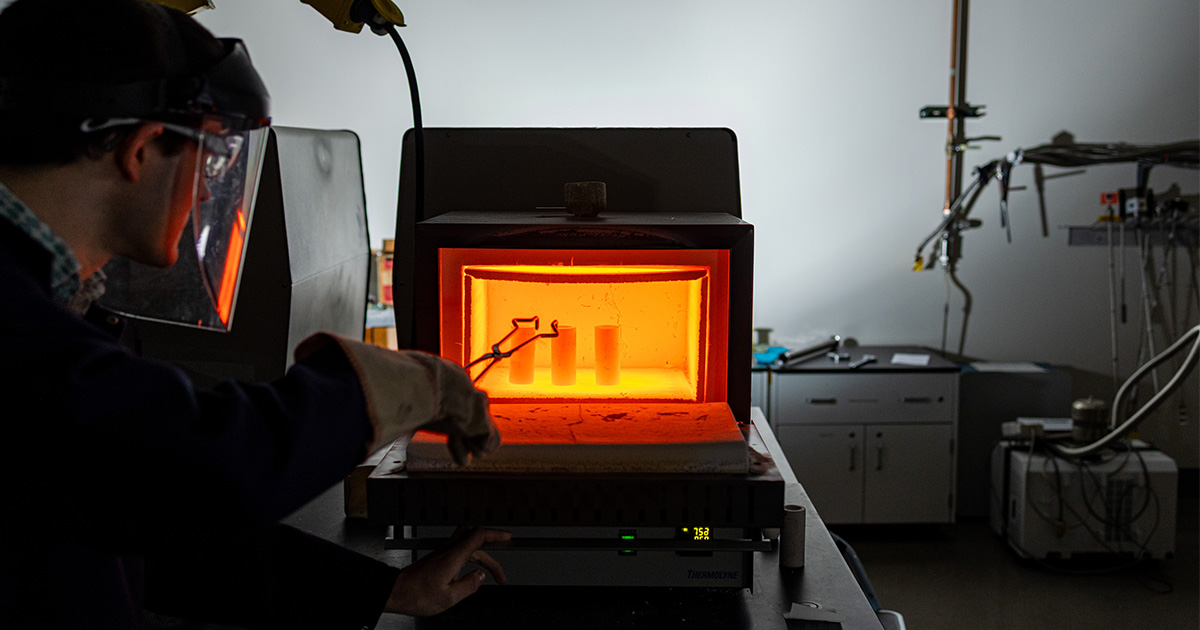Imagine using wires made from three electrically conductive metals to hook three light bulbs up to a battery. Two of the bulbs light up—but the last one flickers and sputters, its electrical supply somehow inconsistent.
UT alum Hasitha Suriya Arachchige (PhD ‘22) encountered this mystery on an atomic scale. As a member of the Emergent Crystalline Matter group (ECM) led by joint UT-Oak Ridge National Laboratory (ORNL) Professor David Mandrus, he had been studying a type of quantum material called kagome lattices.
“The way the atoms are bonded in a kagome lattice causes the electrons to move around in special ways,” explained William Meier, a postdoctoral researcher in the ECM group. “This can be used to create unusual physical properties and make new electrical devices.”

Kagome materials may be the key to many unique phenomena including quantum spin liquids and skyrmion magnets, which are promising for next-generation data storage. Suriya Arachchige had been investigating the properties of kagome materials made with vanadium (V), tin (Sn), and one of three chemically similar rare earth elements: lutetium (Lu), yttrium (Y), or scandium (Sc).
The lattices including lutetium and yttrium atoms transmitted electricity as expected, but the stuttered flow through the scandium compound—ScV6Sn6—presented an exciting opportunity.
“Whenever we discover an unusual behavior in a material,” Meier said, “we ask two questions: ‘Why did that happen? And how can I change it?’”
Catching the Waves
Charge density waves (CDWs) are modified versions of a material’s chemical structure that can alter its electrical properties, leading to strange behavior like ScV6Sn6’s staggered electrical flow.
“It is often challenging to predict when and why CDWs form,” Meier said, “but we are excited to find them, since we can often chemically modify their host materials to find new superconductors.”
The ECM group is fully equipped to investigate CDWs when they appear, with a full suite of elements, furnaces, and equipment dedicated to making unusual materials like ScV6Sn6. UT’s Institute for Advanced Materials and Manufacturing (IAMM) also contains many high-end instruments for characterizing those materials and exploring their properties.

Meier worked with many other members of the ECM group to create pure ScV6Sn6 samples, including postdocs Shirin Mozaffari and Richa Pokharel Madhogaria and two undergraduate students, Caleb Allen and Jeremy Driver. The team also fabricated a series of crystals doped with varying levels of lutetium and yttrium to help determine the ratio of scandium needed to allow the formation of CDWs.
To characterize the crystals’ structures, the team used the equipment at IAMM and collaborated with experts at ORNL and the National High Magnetic Field Laboratory (Maglab) in Florida.
“UT’s strong relationship with the scientists at ORNL was critical for this study,” Meier said. “They helped us plan and execute specialized experiments quickly and efficiently.”
ORNL scientist Michael McGuire evaluated the electrical resistance of each sample from room temperature down to a frigid 0.09 degrees Kelvin (-460° F), looking for signs of superconductivity. (Alas, there are no superconductors in this batch.)
Senior ORNL staff scientist Huibo Cao and postdoctoral researcher Madalynn Marshall obtained detailed data on the crystals’ structures, observing how CDW prevalence changed based on the rare earth elements’ atomic sizes, atomic masses, and other factors.
“We were able to determine that it is the size of the rare earth atom that determines whether a CDW can form,” Meier explained. “Scandium is small enough to give the surrounding atoms room to ‘rattle’, altering the course of the electrons; substituting in the larger lutetium or yttrium atoms removes that extra space and prevents the CDW from forming.”

This hypothesis, which Meier dubbed the rattling chain model, was supported by further experiments by David Graf at MagLab. Graf demonstrated that high pressure—forcing the atoms to stay put—further suppresses CDW formation in lutetium-doped ScV6Sn6 crystals.
“It is often difficult to find a straightforward story in science,” Meier reflected. “This was a rare case where the pieces showed a nice clean story.”
While no new superconductors revealed themselves during the project, Meier is excited to have resolved the mystery of this particular CDW.
“Our work exploring kagome metals is part of a broader search for new quantum materials and their valuable properties,” he said. “My rattling chain model helps us understand the behavior of the materials we have and will let us better predict the behavior of those we try to create.”
Contact
Izzie Gall (865-974-7203, [email protected])
